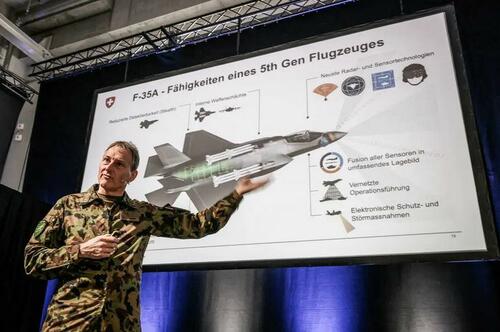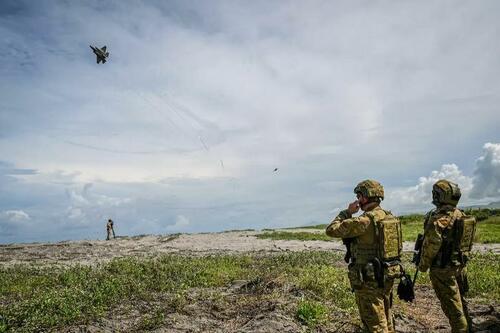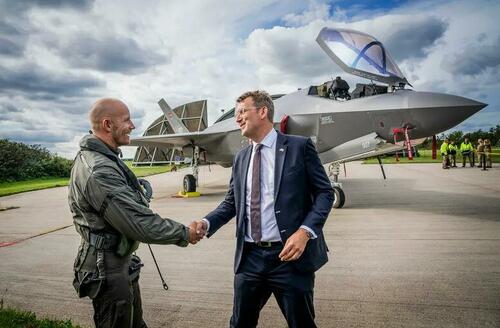America’s Controversial Stealth Fighter Jet Can Now Carry Nukes
Authored by John Haughey via The Epoch Times (emphasis ours),
It was a routine Pentagon announcement during a regular briefing the Friday before the president typically submits his annual defense budget request to Congress on the second Monday in March.
As of October, a spokesman for the Department of Defense’s (DOD) F-35 Joint Program Office told Pentagon beat writers, that “certain” Air Force F-35As have been operationally certified to carry the B61-12 thermonuclear gravity bomb.

While the revelation hasn’t drawn much interest from general news media in the United States, it has spurred extensive commentary within the defense-tech industry. And it is echoing loudly in Europe, most certainly within the Kremlin where Russian President Vladimir Putin has been openly discussing the use of tactical nuclear weapons.
The F-35A nuclear certification and introduction of the B61-12 bomb are key components in a tactical nuclear weapons upgrade in Europe by the North Atlantic Treaty Organization (NATO) in response to Russian saber-rattling—and advances—in battlefield nuclear weapons.
While NATO’s U.S.-built F-16A/Bs and F-16C/Ds and United Kingdom-built PA-200 Tornadoes are also fighter jets authorized to carry nuclear weapons, the F-35A Lightning II is now the first “fifth-generation” stealth fighter to be “dual-capable” of carrying conventional and nuclear weapons, according to the Pentagon.
The F-35A will soon be among NATO’s primary attack-strike jets. Belgium, Germany, Italy, the Netherlands, and Turkey are all stocking their air forces with F-35s, with Germany explicitly doing so because it would be nuclear-capable.
The March 8 announcement also confirmed the full-scale production of the B61-12 bomb. Their predecessors were housed in Belgium, Germany, Italy, and Turkey. According to some reports, they’ve been replacing them with new bombs since December 2022.
October’s nuclear certification was two months earlier than the January 2024 deadline the Pentagon set. Although only publicly acknowledged by the United States on March 8, Dutch military officials wrote in a November X post that their F-35As had achieved “initial certification” to carry nuclear weapons.
Since Pentagon policy prohibits the release of information about NATO partner military capacities, the announcement only addressed “certain” U.S. Air Force F-35As in Europe, with the U.S. fighter wing at Lakenheath in the United Kingdom likely among those upgrading.
“A lot of this is just information warfare, SOP [standard operating procedure] and optics that we got F-35As and allies who have F-35As in Europe,” retired Army Col. John Mills told The Epoch Times.
Mr. Mills, a 33-year Army veteran and former Director for Cybersecurity Policy, Strategy, and International Affairs under the Secretary of Defense, said the F-35A “has always been about Europe.”
“The message is that the F-35s are now there, and they are nuclear certified, and B61-12s are in storage ready to go, ready to be used, if necessary, out of Lakenheath,” he said.
Mr. Mills, who has spoken and written extensively on military matters, including about the F-35A in a column in The Epoch Times, said the announcement was aimed squarely at Mr. Putin.
“Of course,” he said. “He’s the target.”
“If anything, it does create a little bit of angst on the part of the Russians, because that means the [F-35-As] have more potential platforms, more different areas, more places for the Russians to keep track of,” said Mike Fredenburg, founding president of the Adam Smith Institute of San Diego. He writes frequently on defense tech for a wide range of publications, including National Review and The Epoch Times.
“The F-35 has pretty good range for a single-engine fighter. It is stealth, and so you could obviously get closer to Russian air space before being effectively targeted than you could, let’s say, with an F-15,” noting that with 600 to 700 F-35s in U.S. and allied air forces, “we have hundreds of them, and at any given time, some of them are probably capable of flying.”
Mr. Fredenburg admits: “I’m not a huge fan of the F-35.”
So little so that for those who have followed the aircraft’s checkered development for the past 30 years, he had to quantify how truly significant the F-35A certification is. “I don’t want to say it’s insignificant. It does, I think, potentially create some more instability because nobody else has many stealth fighters,” Mr. Fredenburg told The Epoch Times.
“I’d say it’d be more significant if you were putting [a nuclear weapon] on a platform that was more reliable, that you could count on. I guess I could say that.”
A Long, Haunted History
“First of all,” Mr. Fredenburg said, “you have to look at the history. From the very beginning, it was doomed. It was too heavy. There’s no way you can make an engine powerful enough to fly a plane that big. The plane is the largest single-engine plane in the world.”
When first envisioned in the early 1990s, the F-35 was touted by Lockheed Martin as an all-purpose, next-generation stealth joint-force single-engine fighter that would replace up to 16 different types of warcraft, including the Navy’s F-14, the Air Force’s F-16, and the Marine Corps’ Harrier jump jets.
That was nearly two generations ago.
Design began in 1994. After a series of delays, dozens of F-35-equipped squadrons were supposed to be operational at a cost of $233 billion by 2010.
“It didn’t even come close to that,” Mr. Mills said.
By 2016, the project’s cost had doubled. It remains more than a decade behind schedule and billions over budget with mixed results, some say.
“What they did is, you know how you ‘soup up’ your car? Put nitrate in it or something like that? Mr. Fredenburg said. “You might be able to get it around a few times before it blows up, but that’s what they did here.
“They ‘souped up’ the F-22 engine and made it super, super hot to get the horsepower, that thrust, and there’s no way that engine was going to be durable.
“So,” he continued, “it’s got an engine that can’t do the job. It won’t be reliable ever. Ever.”
Read more here…
Tyler Durden
Mon, 04/01/2024 – 23:00
via ZeroHedge News https://ift.tt/NrPHq4m Tyler Durden


